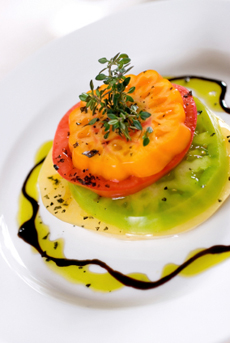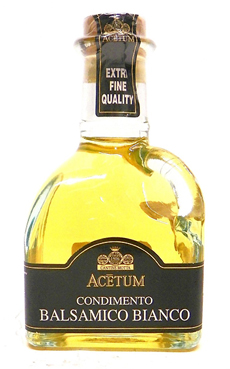TIP OF THE DAY: Fake Versus Real Balsamic Vinegar
|
Spoiler alert: The majority of balsamic vinegar on the market is fake balsamic. Of course, there’s nothing wrong with enjoying fake balsamic. It’s just nowhere as glorious as the real thing, but it is a heck of a lot more affordable. The production of authentic balsamic vinegar is governed by two consortiums of producers in Modena, Italy, where it is produced. They supervise every aspect of production under the strictest controls, from the harvesting of the grapes to the packaging and labeling of the bottles. Even the shape of the bottle is mandated! True aceto balsamico has an Italian government designation of D.O.C. (Denominazione di Origine Controllata, similar to the French A.O.C. designation), which means that everything from the grape varietals to aging time and the type of wood of the barrels adheres to exact standards. |
 A drizzle of authentic balsamic vinegar adds richness and flavor to many different dishes. Photo by Kelly Cline | IST. |
|
|
Compare the minimum-12-year meticulous process that creates authentic balsamic vinegar to “supermarket balsamic,” much of which is ordinary red wine vinegar (perhaps made from Trebbiano grapes) colored with caramel to achieve the dark brown color of an authentic balsamic and sweetened to approximate a balsamic. It may or may not be aged for a short amount of time in large oak barrels or stainless steel barrels. It may be made in a factory in Modena, but at $3.99 a bottle, it’s not authentic balsamic vinegar. (There are “factory balsamics” made in Modena. Read more about them in a longer discussion of balsamic vinegar.) While traditional balsamic vinegar cooks down grape must into a concentrated, flavorful syrup prior to aging, white balsamic producers add cooked-down grape juice to ordinary white wine vinegar. It creates an amber color and a slightly sweet flavor. |
||
 White balsamic vinegar isn’t real balsamic, but neither is much dark balsamic. This 8.45-ounce bottle is less than $14 at Amazon.com. |
WHY WHITE BALSAMIC VINEGAR? While authentic balsamic vinegar dates back to 1046 C.E. (the first written record) or earlier, white balsamic vinegar was created in recent years for consumers who didn’t like the dark color imparted to their recipes by regular balsamic. It’s ideal to use with fish, chicken and pork; in light-color sauces; and in dessert recipes like custard and sabayon. White balsamic vinegar was first produced by Italian vinegar manufacturer Acetum; and a bottle retails for less than $15.00 (you can buy it online). Subsequently, other producers have created “white balsamic vinegar” for $5.00 a bottle and less. To make white balsamic, grape must is added to white wine vinegar; thus, white balsamic is a wine vinegar. The must is cooked at a low temperature to avoid darkening; it is not caramelized. Thus, white balsamic has a desired golden color rather than the dark one of conventional balsamic. White balsamic vinegar emulates the flavor profile of conventional balsamic—gentle and smooth with well-balanced flavor. It is milder and less sweet (more tart) than regular balsamic vinegar, but is sweeter than white wine vinegar and thus delicious on salad greens. |
|
|
For $4.99 a bottle, you’re not getting an aged, artisan-produced bottle of vinegar. For $30 a bottle, some producers do age a Trebbiano-based white balsamic for four years or so, in small oak barrels. Similar to buying a bottle of wine, if your palate can detect the difference, it’s worth it to pay extra for the better ingredient.
|
||